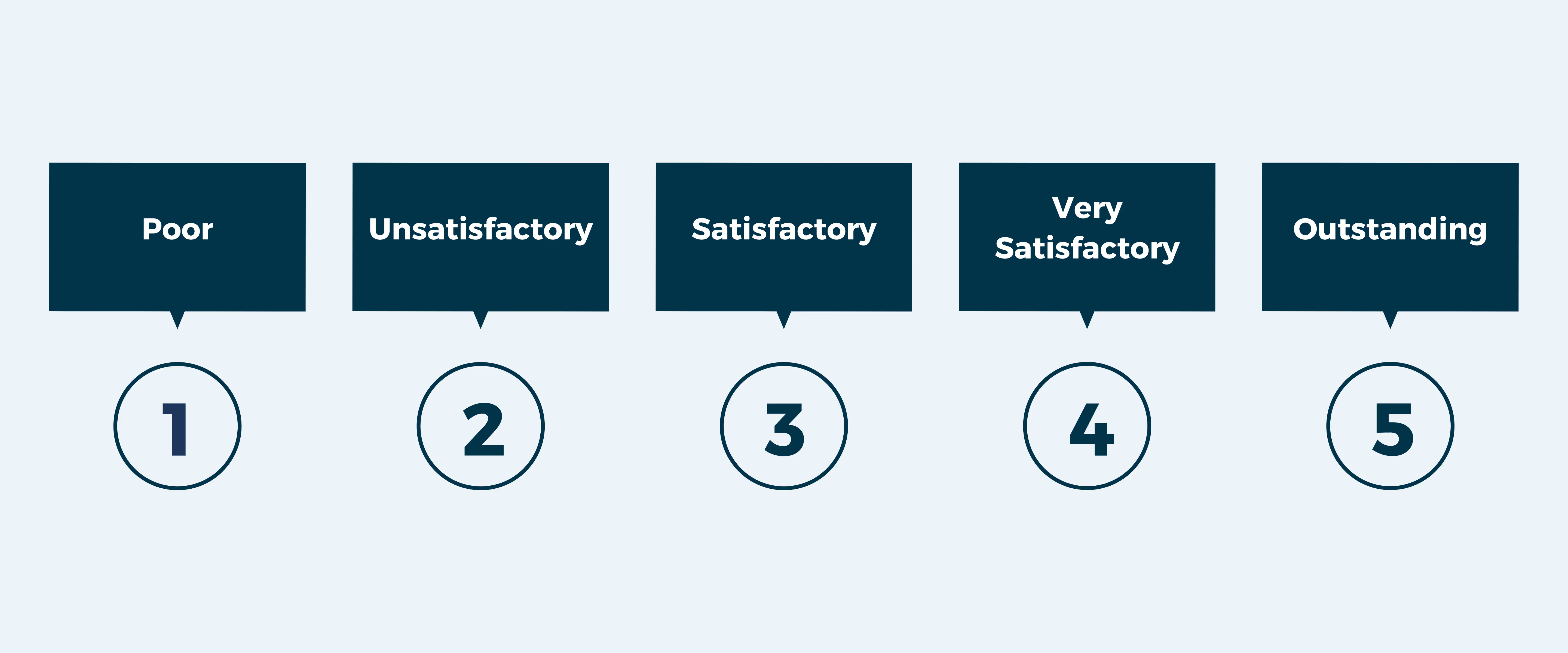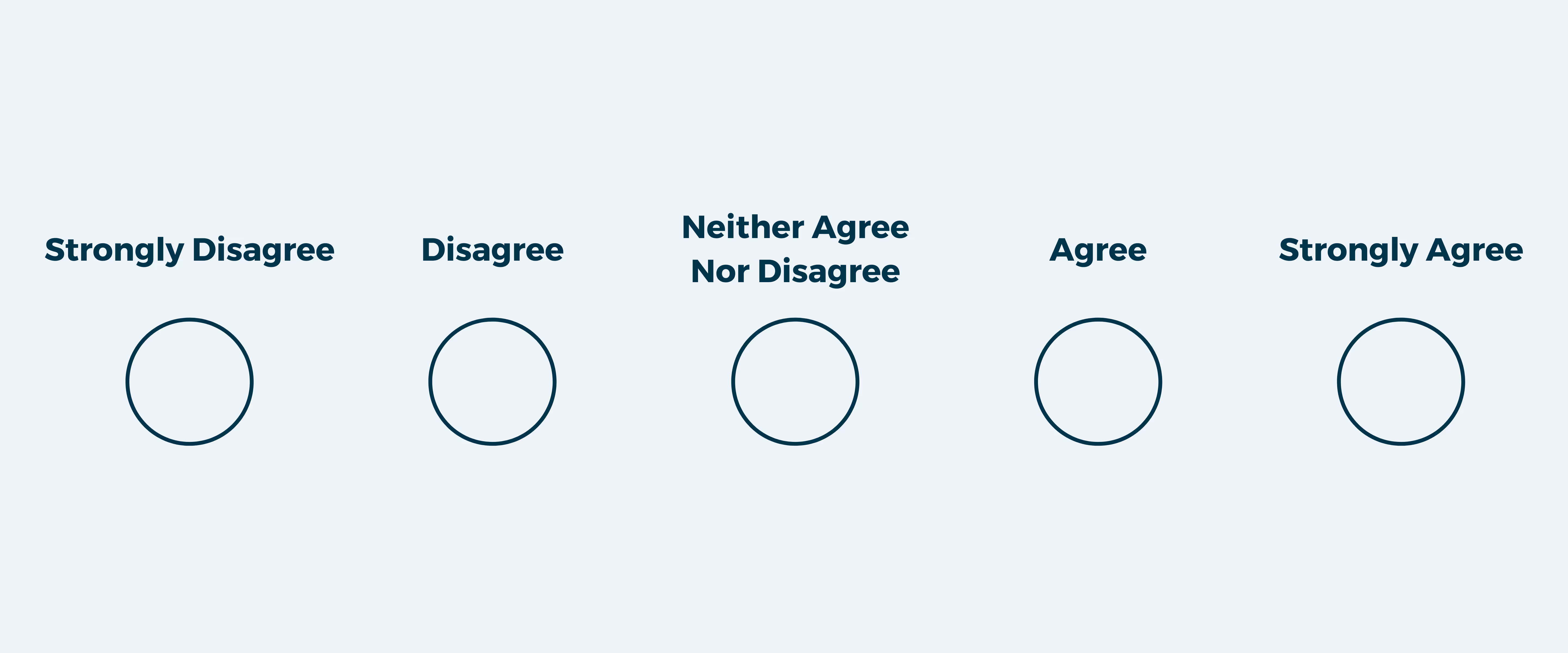Rating Scales for Employee Performance Reviews [Free PDF]
Rating scales are everywhere: After you visit the doctor, watch a show on Netflix, or order food on DoorDash.
They’re also a useful tool for performance reviews. Rating scales help to quantitatively measure employee performance and speed up the appraisal process, allowing organizations to solicit feedback from more people in one review cycle.
In this article, we’re providing examples and ideas to help you create rating scales for your performance management process.
What is a Performance Rating Scale?
A rating scale is one of the most common measures of employee performance or achievement. These scales are simple to roll out, provide a thorough assessment and paint a clear picture of which employees are thriving and which ones need employee development plans.
Click here to download our free PDF explaining the different types of employee rating scales.
There is no one-size-fits-all answer when picking the “best” rating scale for your business. It all boils down to team buy-in. You’ll want employees to trust the process and it’s a fair and honest performance review.
Effectiveness will also hinge on how HR and managers use performance data to make improvements on both an individual and department level. Is it actionable?
Want some tips on how to improve your company's performance management process? Check out our latest video:
That said, there are nuances to be aware of. Some scales may introduce inherent biases. Throughout this piece we'll share insights about how rating scales can impact your company not only in the moment, but also in the long run.
Choosing the Right Rating Scales
There is literally a science to rating scales.
Social scientists have been using questionnaires to collect real scientific data for many decades, so we don't need to reinvent the wheel. We should learn from our scientific colleagues.
Nominal vs. Binary vs. Ordinal Data
Before diving deeper into rating scales, we're going to quickly review the three types of data that are most often collected on employee appraisal forms: nominal, binary, and ordinal.
Nominal = Categories

When the answer options have no relationship to each other (aren’t ordered or don't have any numeric relationship), you are asking a question that will generate nominal data.
These are not technically rating scale questions, but are commonly found on review forms.
Binary = Yes or No (either or)

Binary data is always an either or answer, with the most common example being yes or no.
Other examples include:
- Exists or doesn’t exist
- Is or is not
- Complete or incomplete
Deloitte collects binary data in 2 of the 4 questions on their review form. Google collects binary data on their upward reviews of managers.
Ordinal = Ordered List

Ordinal data is collected when we ask rating scale questions. The answers to a question will be a list of possibilities that have a clear order or ranking.
As you move up the scale, options should clearly be better/more and as you move down the scale, the options should be worse/less.
Click here to download our free PDF explaining the different types of employee rating scales.
Numeric vs. Descriptive Answers
There are two common ways to present rating scale answers: numeric and descriptive.
Numeric: Just Numbers
Example: “Score the employee’s leadership ability between 1 and 5.”
Numeric scales only include numbers and rightfully get a lot of pushback.
It can be really hard for managers to understand what constitutes a 4 vs. a 5 when it comes to subjective competencies like “assertiveness.”
Descriptive: Ordered Descriptions
Example: Everything from Agree to Disagree, all the way to Behaviorally Anchored Rating Scales.
Descriptive rating scales include descriptions of what each step up on the scale looks like.
This could be as simple as different levels of agreement or complex as a set of specific actions an employee should have taken to achieve each level.
Most Common Rating Scales: Likert vs. Semantic vs. Custom
Likert Scales

Likert scales measure our response to a statement, with the most common example being: Strongly Disagree - Disagree - Neither Agree nor Disagree - Agree - Strongly Agree.
Well designed likert scales will be symmetrical, with an equal number of positive and negative responses. They will also be balanced with what feels like the same distance between each choice.
Five choices is the most common number on a likert scale, but any number can be used.
One of the most important decisions to make is whether to give an odd or even number.
An odd number of choices will mean the central option is neutral, neither positive or negative.
An even number of options is sometimes called a “forced choice” and does not give a neutral option, so the respondent has to pick a side.
Semantic Scales

Semantic scales are similar to likert scales but present two extremes with unnamed options in between.
For example, you might ask an employee to rate a recent project between success and failure with 7 options in between.
Custom Scales
Custom scales are common because they allow HR teams to create their own scales to fit their needs.
A risk of custom scales is that they can lead to unexpected distortions in data. Below are several real-life examples of custom rating scales to help you see how they can be used effectively.
Examples of Rating Scales in Action
UC Berkeley
The University of California, Berkeley Human Resources Department currently conducts performance appraisals with a 5-level rating scale, ranging from Exceptional to Unsatisfactory.
Supervisors that assign a Level 2 (Improvement Needed) or Level 1 (Unsatisfactory) rating to an employee must complete a performance improvement plan for that employee.
This plan is developed to improve or correct poor performance, containing timelines that are outlined and monitored to measure the employee’s progress.
A Level 5 (Exceptional) rating is said to be achievable, but given fairly infrequently. High-performing employees often receive a Level 4 (Exceeds Expectations) or Level 3 (Meets Expectations) rating.
Huntington Ingalls
This company uses a rating system that is both numerical and alphabetical, focused on whether or not employees meet company goals.
Their 5-point scale assigns abbreviations that coincide with each numerical ranking:
- 5 = FE (Far Exceeds)
- 4 = EX (Exceeds Expectations)
- 3 = ME (Meets Expectations)
- 2 = DR (Development Required)
- 1 = IR (Improvement Required)
Harvard
Harvard makes use of multiple rating scales within their organization, including overall performance ratings of employees, goals, competencies, and direct report ratings.
Overall performance ratings are given on a 5-point scale, observing employees with performances that are:
- 5 = Leading
- 4 = Strong
- 3 = Solid
- 2 = Building
- 1 = Not Meeting Expectations
Goals are also tracked using a 3-point rating scale that measures whether a goal or project was on time, on budget, and accomplished.
- 3 = Goal Was Met
- 2 = Goal Was Partially Met
- 1 = Goal Was Unfinished (Most or All Dimensions Were Not Achieved)
Competencies ratings are given to employees who demonstrate thorough to lacking knowledge of the organization’s core competencies. This 4-point scale includes the following:
- 4 = Advanced
- 3 = Proficient
- 2 = Developing
- 1 = Does Not Demonstrate
Direct report ratings are reserved for managers only and determine whether the ratee’s capabilities are:
- 3 = Highly Effective
- 2 = Effective
- 1 = Needs Improvement
Emory University
Emory University’s HR team operates an in-depth rating system that is similar to BARS.
Each employee is rated against a long list of unique core competencies that the organization abides by:
- Building Trust
- Collaboration
- Communication
- Delivering Results
- Problem Solving
- Taking Initiative
- Functional Knowledge and Skills
- Service to Others/Customer Focus
Each of these categories deals with how well an employee displays honesty, respect, listening and sharing, productivity, decision making, and reasoning.
The competencies are rated with a 3-point system:
- 3 = Exceeds Expectations
- 2 = Meets Expectations
- 1 = Unacceptable
All ratings apply to supervisors and managers, as well as non-managers.
More Examples
Binary Rating Scale Examples
- Needs Improvement | Meets Expectations
- Needs Attention | Satisfactory
1-3 Rating Scale Examples
- Does Not Meet | Meets | Exceeds
- Below Level | At Level | Above Level
- Not Often Enough | From Time to Time | Most of the Time
- Minor Contribution | Important Contribution | Critical Contribution
1-4 Rating Scale Examples
- Never | Sometimes | Often | Always
- Low Performer | Developing Performer | Highly Valued Performer | Top Performer
1-5 Rating Scale Examples
- Unsatisfactory | Needs Improvement | Meets Expectations | Exceeds Expectations | Distinguished
- Unacceptable | Needs Improvement | Acceptable | Good | Excellent
- Did not meet expectations | Met some but not all expectations | Fully met expectations | Exceeded expectations | Significantly exceeded expectations
- Area of Deficiency | Inconsistently Meets Standards | Meets Standards | Meets High Standards | Regularly Exceeds High Standards
- Needs Improvement | Consistently Meets Expectations | Exceeds Expectations | Strongly Exceeds Expectations | Superb
- Unsatisfactory | Meets Most | Fully Meets and Sometimes Exceeds | Consistently Exceeds | Far Exceeds
- Unacceptable Performance | Partially Successful | Fully Successful | Superior | Distinguished Performance
- Poor | Below Average | Good | Very Good | Outstanding
» Interested in performance management software? Compare Lattice vs Culture Amp vs PerformYard.
Click here to download our free PDF explaining the different types of employee rating scales.
Frequently Asked Questions
What is the best performance rating scale?
As we said earlier, it comes down to company goals and what works best within the company's culture. Rating scales indicate an employee's level of performance or achievement and provide quantitative assessments. Most performance ratings share common elements, like either being numeric or alphabetic. Others may take on the form of a narrative. A company should weigh its options and consider which method provides the most substantial insight into its worker's performance. What works for one company may not be a fit for another.
What rating scale is most used?
Many organizations use the standard three or four-point rating scale. Both of these work for measuring specific criteria, but these may need more nuance to make appropriate assessments, which is why other companies rely on the BARS method. (See above for more information on BARS.)
What are Behaviorally Anchored Rating Scales?
A behaviorally anchored rating scale (BARS) assesses new employee performance based on established behavioral patterns, which rates individual employees and is a critical component of a structured interview.
What are competency rating scales?
Generally, the same rating scale stretches across content areas suggesting an employee's evaluation from goals to competencies, which typically fall into Core, Functional, and Cross-Functional. These are calculated as a sum of the individual competency percent divided by the number of competencies within a group.
How to give ratings to employees?
After you've executed one of these rating systems, there are best practices to follow when providing the data back to the employees. For example, be mindful of providing a consistent assessment that plainly shows the data. Moreover, managers should be intentional about taking notes and going over the data. If someone is performing well, they should be acknowledged for the work put in, as it sends a consistent signal that you're paying attention.



.jpg)

